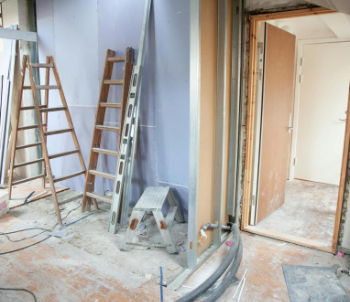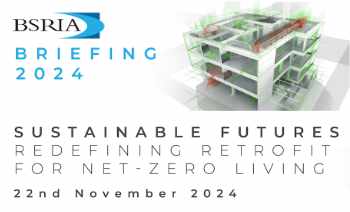Project 80: Homes for the Future
Climate change and what we can do to address it, both individually and collectively, has become the defining issue of our age. The expectation from Government, consumers and future generations alike will be for organisations to significantly reduce their impact on the environment, reducing their carbon footprint and creating less waste. This is an expectation enshrined in the UK’s legal requirement to bring all greenhouse gas emissions to net zero by 2050.
Contents |
[edit] The Future Homes Standard
The UK’s housing stock accounts for about 15% of the UK’s annual greenhouse gas emissions. Because of this significant contribution the new-build housing sector is seeing a changing landscape in relation to the energy performance of the homes we produce in the future.
The foremost challenge we face is The Future Homes Standard (FHS), which will become a Building Regulation requirement from 2025.
The FHS will see the introduction of tougher low- carbon regulation for new homes built from 2025. New homes will generally emit 75-80% less carbon than homes built under current regulations. This 75-80% reduction is to be achieved through a need to: meet more stringent building fabric requirements; utilise a low-carbon form of heating and hot water (including the probable introduction of a ban on gas boilers in new-build homes).
[edit] Challenges of FHS
Due to the tougher building fabric requirements and introduction of low-carbon forms of heating and hot water in Future Homes we (who act as a landlord, asset manager, and developer of homes) are conscious that many of our residents will not be familiar with the technologies that will be used within properties built to the FHS, nor the wider way of living in them to maximize the benefit of their home’s performance. The combination of change for us (in the way we design, build and maintain these homes) and our residents (in the way they use and interact with these homes) is something we need to better understand to ensure success come 2025.
[edit] Project 80
To understand the Future Homes challenge, we have created ‘Project 80’ which is a research and development programme in conjunction with Birmingham City University (BCU), key product manufacturers and industry bodies, and contractors. Together, we will develop, monitor and understand over 50 homes that meet the FHS before 2025. Project 80 will generate a significant body of knowledge to enable us to understand what works for us and our residents, including:
- Identifying the information requirements of our residents along with the most suitable method of disseminating that information,
- Evaluating the performance of different products and technologies (both technically and from a user perspective),
- Understanding design principles that that work well and should be adopted as standard,
- Limiting any problems to a controlled environment and establishing what changes need to be made to overcome them, to avoid them becoming the norm in 2025,
- Establishing methods to ensure value for money whilst maintaining performance, Allowing us to make Future Homes decisions based on rigorous empirical evidence.
[edit] General methodology
As the FHS is not fully defined and software to model it is not available, we developed an approach to modelling the FHS based on known information. This started with us establishing a baseline. To establish this baseline, we modelled the plots to meet the current Building Regulations, which gave us our ‘Maximum Kg CO2/yr’. We then re-modelled the units in SAP 10 and adopted two principles: a) we incorporated low carbon forms of heating and hot water generation; and b) we aimed for an 80% CO2 emissions reduction – this enabled us to determine the performance and design criteria for the particular plots. The table outlines the difference in FHS spec and 2013 Building Regulation requirement for plot 5 on Eco Drive.
[edit] Phase 1: Eco Drive – Handsworth
The first homes that modelled the FHS are our 12 homes on Eco Drive in Handsworth, designed by Oakley Architects and developed by Tricas Construction. The homes on Eco Drive were designed to provide superior insulation, as well as incorporating low and zero carbon technologies.
In general, the combination of fabric improvements, low-carbon heating systems and other low and zero carbon technologies means that this development has achieved a CO2 emission reduction of between 80% and 90% compared to current Building Regulation requirements – based on the SAP calculations.
For example, plot 1’s CO2 emissions have reduced from 16Kg/m2/yr to just 2.4 Kg/m2/yr, plot 3 has reduced from 18Kg/m2/yr to 3.7Kg/m2/yr; and, plot 5 has reduced from 17Kg/m2/yr to 1.7 Kg/m2/yr. This reduction has significantly reduced the operational impact of these homes on the environment. In addition, the heating loads have reduced by approximately 60%, which has contributed to an anticipated reduction of 65% to the overall running cost of the properties. This anticipated reduction in running cost presents a significant cost saving for our residents.
As this was our first FHS project, and because there are multiple ways to model the FHS we incorporated different specifications to maximise the research benefit. The majority of the specification remained consistent such as u-values of the fabric, and the utilisation of technologies such as PV, and WWHR. however, on specific plots we altered the block density; incorporated differing airtightness levels (and ventilation strategies); and utilised various heating and hot water approaches provided by differing manufacturers for each system. These approaches are discussed in more detail, against the individual plots.
[edit] Plots 1-2
These plots are 4-bedroom 3 storey houses and have been designed to achieve a high airtightness. Because of this airtightness we have incorporated mechanical ventilation with heat recovery (MVHR) to ensure the homes are ventilated property. The reason for making the homes
so airtight is to understand how our residents interact with a highly airtight home which utilises a mechanical ventilation system. For heating and hot water, we are using Baxi air source heat pumps and hot water cylinders to explore different products and how they perform.
[edit] Plots 3-4
These plots are 2-bedroom 2 storey houses, they have
the same airtightness and ventilation strategy as plots 1-2. Where these plots differ is that they incorporate GlenDimplex panel heaters and hot water heat pumps, which is aimed at understanding residents’ views on their useability and performance when compared to air source heat pumps. The other difference with these plots is the ‘g value’ of the windows, which was changed from 0.45 to 0.37 to overcome a potential overheating risk identified by the TM59 overheating analysis.
[edit] Plots 5-12
These plots are 3-bedroom 21⁄2 storey houses and
have been designed to achieve a lower airtightness in conjunction with ‘natural ventilation’, with the logic being to explore whether our residents interact differently (or better) with a less airtight home which utilises a natural ventilation system – to inform our thinking come 2025. For heating and hot water, we are using Vaillant air source heat pumps and hot water cylinders to explore different products and how they perform.
[edit] Increase in build cost
The cost analysis shows that the total cost of the FHS scheme is 13% more than if it had been delivered to meet current the Building Regulations only, this cost analysis takes into account the recent cost increases across our sector. There are several elements that have contributed to the cost increase, including: the change in insulation type, the transition from combi boilers to heat pumps
and hot water cylinders, better performing windows with different g-values, and additional technologies such as PV, MVHR, and WWHR.
The change from blown fibre to PIR insulation there was a cost increase of 79% (in the insulation price) taking it from a typical 0.5% of the contract sum, to 2.2%. We also saw a 21% increase in the cost of bricklayers to install the PIR system. With regards to the transition away from gas combi boilers we saw the cost of the M&E package
(in relation to these elements) increase by 38% taking it from 7% under current Building Regulations to 9% under the FHS specification. Because of the increased u-values and change in g-value for the windows, we again saw a 38% cost increase, with windows (and doors) normally accounting for 2.4% of contract sum, but now accounting for 3.4%. In addition to these costs, we also encountered a significant rise in the cost of the electrical connection to the site – due to the higher electrical demand. Historically, a gas and electrical connection to a site of this size has cost circa 0.8% of the contract sum respectively (1.6% collectively). Whilst we benefitted from a cost saving in relation to having no gas connection to the site, we saw an overall increase in the electrical connection of 72%, taking the cost to 2.4% of the contract sum (and more than we would have expected to have paid for a gas and electrical connection combined).
[edit] Data capture and documentation
In addition to the design and specification changes, there is also the introduction of a requirement to document and demonstrate that the as-built version of the dwelling concords with the details that form the SAP calculation. To explore how we will achieve this; we have worked with Captego to trial their inspection and data recording app. The Captego app has enabled us to set-up a ‘digital project’ for the site, upload the relevant site details including the site layout, specific plot details and drawings. In addition to plans, we can upload pictures of critical details such as the calculated thermal bridging details we have used in the SAP calcs, as well as specification details.
By uploading all this information, we can take time and location stamped photos of the construction work to demonstrate compliance with the design and specification for the specific plots. In addition to using the Captego app to document specification items and critical details, we are also using the app to document progress on-site and as a site inspection tool to monitor quality. The reason for using it to capture progress of the plots, is so we can get an end-to-end view of the construction of the plots and check whether work is on track with the programme. The benefit of using the app as part of the site inspection and quality control process is that it enables you to clearly mark on the site plan where the picture is taken of and assign the non-conformance/ defect to the relevant party who needs to rectify it. Upon rectification of the work, the defect can be closed out and an additional photo of the rectified problem uploaded.
[edit] Research and Monitoring
Both us (Midland Heart) and researchers at Birmingham City University (BCU) are working closely with our customers to understand how easy the homes are to live in – given the new technology, how energy efficient the properties are – in reality, how cost effective they are, and the living environment in terms of indoor air quality and temperature.
- Pre-move in workshops with residents: as our residents will be using many of the technologies in the home for the first time, we understand the need to provide them with a detailed induction to the home. This was done via a workshop with the contractor and system manufacturers. The workshops demonstrated the technologies and provided details of how to use them and key items of consideration. The M&E contractor recorded instructional videos for the residents for them to refer to and refresh themselves on as and when needed.
- POEs of resident experience: with the residents using the technologies for the first time, we are keen to understand how they are interacting with the property for the first-year post-completion, how they are living in the properties, any concerns they have or questions that are raised, and anything that we could have done better with both the property and the pre-move in experience.
- Energy use and cost monitoring; indoor air-quality monitoring; and, temperature monitoring: prior to occupation of the plots, they were monitored to establish a baseline of performance. During the first year of occupancy, we will continue to monitor the plots to verify how they perform compared to the design calculations as well as the baseline monitoring. Where there are differences, we will seek to understand why they have happened and develop strategies to overcome them.
- Thermal imaging: when the temperature conditions are suitable, we will undertake a thermal imaging survey, so we can establish whether there are any problematic areas, or areas that aren’t performing how they should be, so we can develop strategies to reduce or eliminate their occurrence on our future Project 80 developments.All the evidence we gather will help to inform future policy on how we build new homes in a way that’s good for the environment and useable for our residents.
[edit] Elvetham Road – Edgbaston
The second homes to model the FHS are our 12 maisonettes at Elvetham Road in Edgbaston, designed
by BM3 and being developed by Tricas Construction. This scheme is due for handover in Summer 2022. This scheme allowed us to explore different solutions to model the FHS along with a block compliance approach. In general, the combination of fabric improvements, low- carbon heating systems and other low and zero carbon technologies means that this development has achieved a SAP calculation CO2 emission reduction of 80% compared to current Building Regulation requirements. Across the blocks the CO2 emissions have reduced from an average of 27Kg/m2/yr to just 5.4 Kg/m2/yr.
The initial calculated cost increase on Elvetham Road is approximately 14%, for similar reasons as noted on Eco Drive. However, upon completion we will undertake a detailed cost analysis.
[edit] Project partners
We have been working with key manufacturers and contributors during the project and have had an industry steering group. By utilising manufacturers and other contributors, we have been able to tap into their expertise of their products and work together to bounce ideas off of each other when specifying the site(s), and tap into the wider capabilities of the organisations to ensure the homes model the FHS correctly and give Project 80 the best chance of Succeeding. For example, Besblock have undertaken sense check SAP calculations and provided a complimentary air test service; Baxi have provided training to subcontractors; and, Xtratherm have provided bespoke thermal bridging values.
[edit] Summary
There are multiple ways of modelling the FHS, and the Eco Drive project has provided valuable learning so far and will continue to provide more crucial data over the next year when we monitor the properties. The 12 Future Homes maisonettes on Elvetham Road in Edgbaston have given us a further chance to explore different methods of achieving the FHS and understand different approaches and technologies. We will continue to run Project 80 to model different approaches and methodologies to model the FHS for different property types between now and 2025, and we are looking at some framed buildings on a scheme due to start on site shortly.
This article originally appeared under the same title in the AT Journal Issue 142 Summer 2022, it was written by Dr Tony Hopkin CEng FCABE FCIOB MSFPE, Head of Construction, Quality and Innovation, Midland Heart
--CIAT
[edit] Related articles on Designing Buildings
Featured articles and news
HBPT and BEAMS Jubilees. Book review.
Does the first Labour budget deliver for the built environment?
What does the UK Budget mean for electrical contractors?
Mixed response as business pays, are there silver linings?
A brownfield housing boost for Liverpool
A 56 million investment from Homes England now approved.
Fostering a future-ready workforce through collaboration
Collaborative Futures: Competence, Capability and Capacity, published and available for download.
Considerate Constructors Scheme acquires Building A Safer Future
Acquisition defines a new era for safety in construction.
AT Awards evening 2024; the winners and finalists
Recognising professionals with outstanding achievements.
Reactions to the Autumn Budget announcement
And key elements of the quoted budget to rebuild Britain.
Chancellor of the Exchequer delivers Budget
Repairing, fixing, rebuilding, protecting and strengthening.
Expectation management in building design
Interest, management, occupant satisfaction and the performance gap.
Connecting conservation research and practice with IHBC
State of the art heritage research & practice and guidance.
Innovative Silica Safety Toolkit
Receives funding boost in memory of construction visionary.
Gentle density and the current context of planning changes
How should designers deliver it now as it appears in NPPF.
Sustainable Futures. Redefining Retrofit for Net Zero Living
More speakers confirmed for BSRIA Briefing 2024.
Making the most of urban land: Brownfield Passports
Policy paper in brief with industry responses welcomed.
The boundaries and networks of the Magonsæte.































